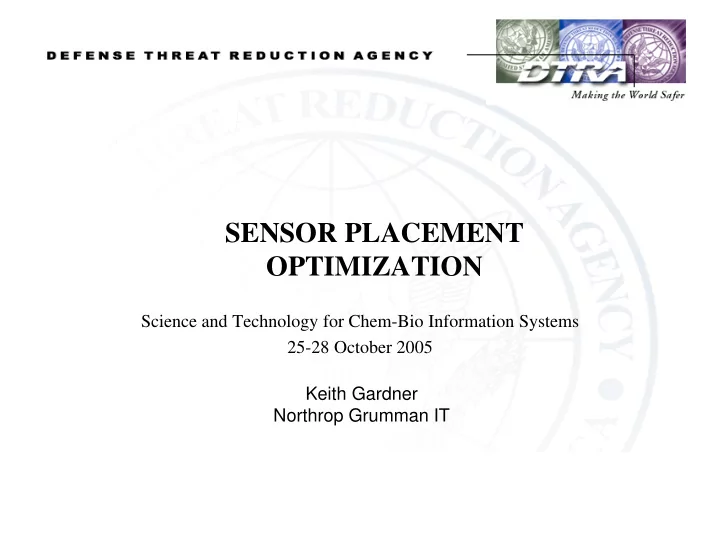

SENSOR PLACEMENT OPTIMIZATION Science and Technology for Chem-Bio Information Systems 25-28 October 2005 Keith Gardner Northrop Grumman IT
Problem of Interest • Multiple Biological detectors to be placed around and within a fixed facility as passive defense measure • Look at sensor placement options with fast running tool to generate statistical measures • Definition of performance metric – Prior work accepted “at least one hit” on sensor as adequate – Relationship between metric and operational use of multiple sensors – Consider imperfect attacks • Overall goal to create optimization tool to determine geometry, spacing and number of sensors Science and Technology for Chem- Bio Information Systems
Theoretical approach • Buffon’s Needle: What is the probability that a needle hits crack in floor? It is a function of needle length and space between cracks. Science and Technology for Chem- Bio Information Systems
If the plane is instead tiled with congruent triangles with sides a, b, c and a needle with length l , less than the shortest altitude is thrown, the probability that the needle is contained entirely within one of the triangles is given by Where A, B and C are the angles opposite a, b and c respectively, and K is the area of the triangle. What about dropping triangles on points, like a deadly plume on a sensor field? Too difficult – try a simulation. Mathworld.wolfram.com Science and Technology for Chem- Bio Information Systems
Example Configuration CB Sensor “Plume” Contour Source Origin Placement Defended Region “Margin” Source Region Science and Technology for Chem- Bio Information Systems
Basic Scoring Approaches • Count number of detections – Score = number of detections – Problems: unbounded, had to compare different size arrays; sensitivity • One or more hits is good (war posture, false alarms not considered) – Score = number of runs with one or more hits / total number of runs • More than one is better (homeland posture, avoid false alarms) – Score = number of runs with two or more – number of runs with zero hits / total runs • Areas weights =>> score * plume area / base area – Values cases where plume covers center of defended region • Power law weights (optimization routine, declining return) – Score = (2 i -1)/2 (i-1) or {0, 1, 1.5, 1.75, .. => 2.0} – Allows additional weight (discrimination) for more hits Science and Technology for Chem- Bio Information Systems
comparison of scoring approaches 1.0 0.9 multi - zero 0.8 multi - zero with area weighted area 0.7 multi hits 0.6 score 0.5 0.4 0.3 0.2 0.1 0.0 -1.0 -0.5 0.0 0.5 1.0 1.5 2.0 2.5 3.0 margin Science and Technology for Chem- Bio Information Systems
Grid Configurations Perimeter Perimeter with Margin Uniform Array Dice 5 Perimeter with Center Perimeter - 2 Tiers Random Circle Circle, Margin, Center, Corners Ellipse Science and Technology for Chem- Bio Information Systems
Scenario Parameters • Defended Region: 16 km x 19 km • Plume Source Region: 24 km x 27 km, centered on Defended Region • Plume: 25 km length, 10 degree arc width • Scenario Control: 2500 trials per run, fixed seed • Sensor Configuration: Margin = 0.0 Science and Technology for Chem- Bio Information Systems
Single Hit Performance Metric 1.000 0.900 0.800 Score Perimeter 0.700 Uniform Dice 5 0.600 0.500 0.400 0 10 20 30 40 50 Number of Sensors Science and Technology for Chem- Bio Information Systems
Multiple Hit Performance Metric 1.000 0.900 0.800 0.700 0.600 Score 0.500 Perimeter Uniform 0.400 Dice 5 0.300 0.200 0.100 0.000 15 20 25 30 35 40 45 50 55 Number of Sensors Science and Technology for Chem- Bio Information Systems
Perimeter vs Uniform for multiple hits If the sensors are far apart, it is difficult to hit two or more with Perimeter. Uniform is preferred with limited sensors. Science and Technology for Chem- Bio Information Systems
Power Law Performance Metric 0.700 0.600 0.500 Score 0.400 Perimeter Uniform Dice 5 0.300 0.200 0 10 20 30 40 50 Number of Sensors Science and Technology for Chem- Bio Information Systems
Geometry Comparison 1.000 0.900 P e r f o r m a n c e S c o r e 0.800 0.700 Basic Score 0.600 Power Series Area Weight 0.500 Power & Area 0.400 Perimeter Uniform Dice 5 (33) Perimeter Perimeter Perimeter Circular Circular w/ Circular w/ Circular 2 Ellipse Ellipse w/ Ellipse w/ Ellipse 2 (36) (6x6) (2 tier) (2 tier with (w/ center) center center & tiers w/ center center & tiers w/ center) corners center & corners center and corners corners Configuration Science and Technology for Chem- Bio Information Systems
Observations • Dice 5 configurations offer no advantage over uniform arrays • Configurations that conform to defended region “work better” than configurations that don’t conform • Perimeter geometries and uniform arrays have a crossing point as number of sensors is increased • Scoring system must take into account tactical motivations, false alarms, forensics, etc. • Optimization using Tabu search should be able to optimize margin, spacing and number of sensors for a given area, especially with warm start provided by this tool Science and Technology for Chem- Bio Information Systems
Future Areas for Study • Optimization of sensor placement – Spacing (wind), geometry (spiral), margin, number, cost, performance – More realistic sensor performance/ Mixed sensitivity • Chemical versus Bio plume size consideration – Topology, terrain, day/night, etc. • Quantitative specification of perimeter/uniform cross-over point • Non-rectangular defended regions Science and Technology for Chem- Bio Information Systems
Recommend
More recommend